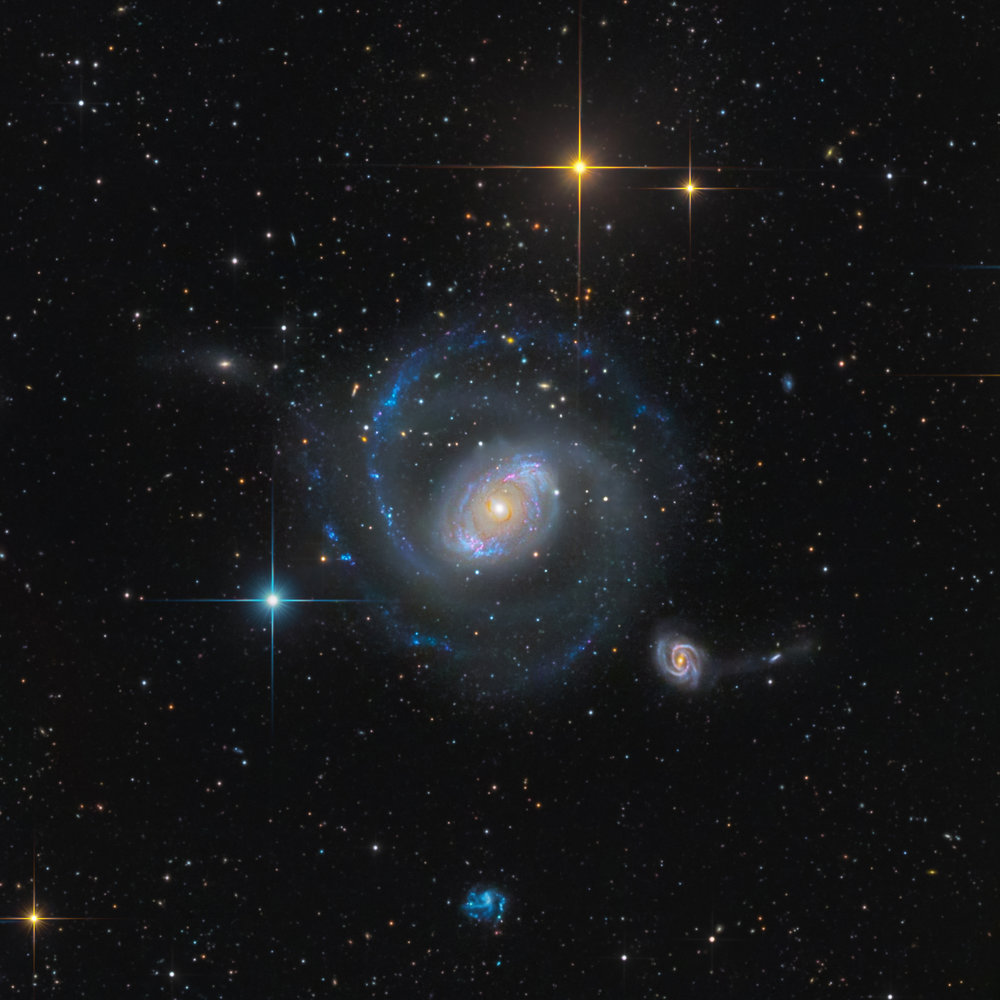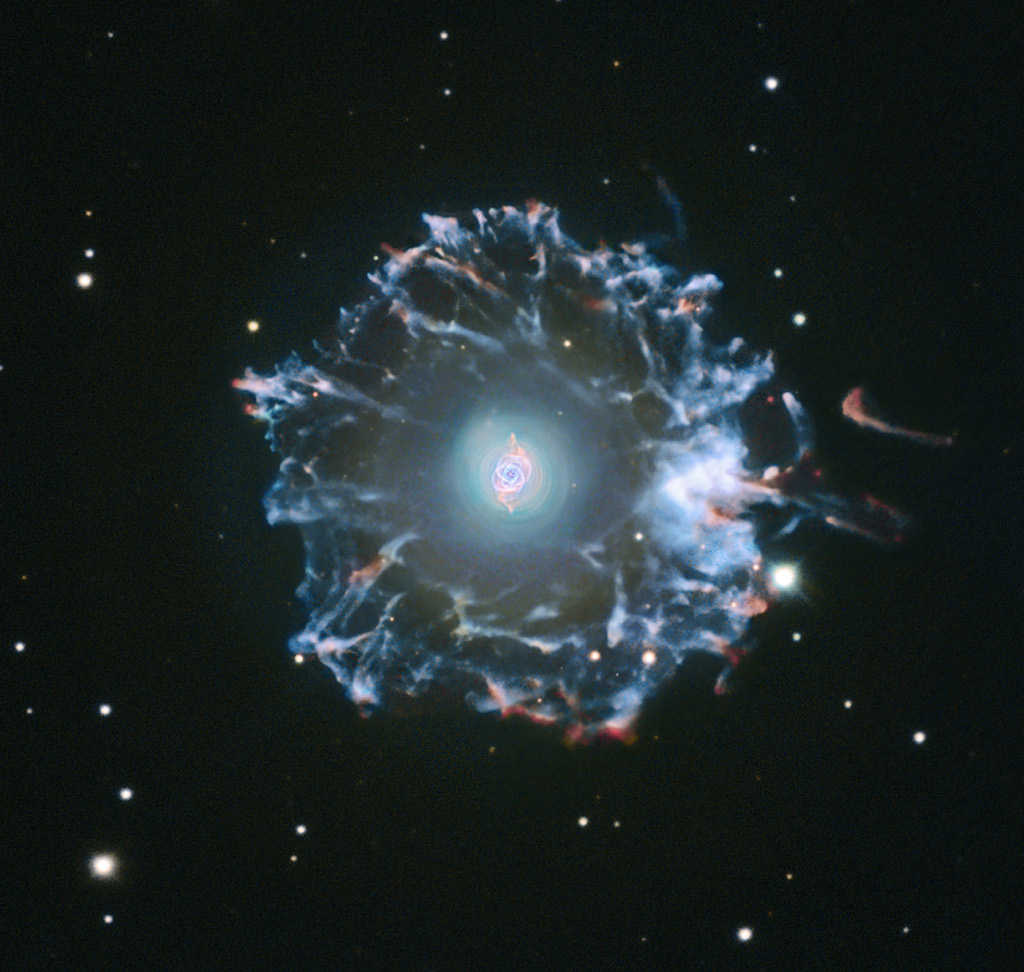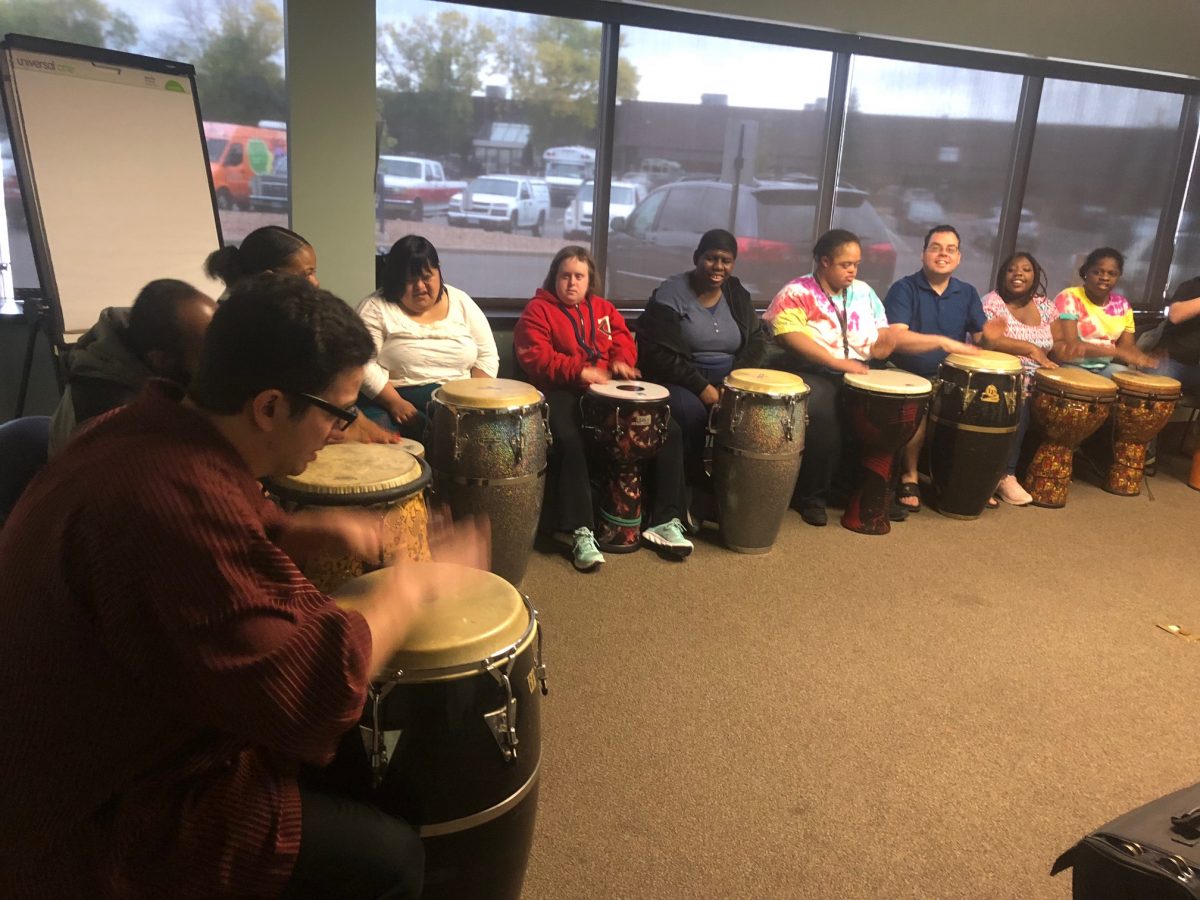Blog
The galaxy lies 13 million light-years away in the southern constellation Circinus. This galaxy is designated a type 2 Seyfert, a class of mostly spiral galaxies that have compact centers and are believed to contain massive black holes. Seyfert galaxies are themselves part of a larger class of objects called Active Galactic Nuclei or AGN. AGN have the ability to remove gas from the centers of their galaxies by blowing it out into space at phenomenal speeds. Astronomers studying the Circinus galaxy are seeing evidence of a powerful AGN at the center of this galaxy as well. Much of the gas in the disk of the Circinus spiral is concentrated in two specific rings — a larger one of diameter 1,300 light-years, which has already been observed by ground-based telescopes, and a previously unseen ring of diameter 260 light-years. In the Hubble image, the smaller inner ring is located on the inside of the green disk. The larger outer ring extends off the image and is in the plane of the galaxy’s disk. Both rings are home to large amounts of gas and dust as well as areas of major “starburst” activity, where new stars are rapidly forming on timescales of 40 – 150 million years, much shorter than the age of the entire galaxy. At the center of the starburst rings is the Seyfert nucleus, the believed signature of a supermassive black hole that is accreting surrounding gas and dust. The black hole and its accretion disk are expelling gas out of the galaxy’s disk and into its halo (the region above and below the disk). The detailed structure of this gas is seen as magenta-colored streamers extending towards the top of the image. In the center of the galaxy and within the inner starburst ring is a V-shaped structure of gas. The structure appears whitish-pink in this composite image, made up of four filters. Two filters capture the narrow lines from atomic transitions in oxygen and hydrogen; two wider filters detect green and near-infrared light. In the narrow-band filters, the V-shaped structure is very pronounced. This region, which is the projection of a three-dimensional cone extending from the nucleus to the galaxy’s halo, contains gas that has been heated by radiation emitted by the accreting black hole. A “counter-cone,” believed to be present, is obscured from view by dust in the galaxy’s disk. Ultraviolet radiation emerging from the central source excites nearby gas causing it to glow. The excited gas is beamed into the oppositely directed cones like two giant searchlights. Located near the plane of our own Milky Way Galaxy, the Circinus galaxy is partially hidden by intervening dust along our line of sight. As a result, the galaxy went unnoticed until about 25 years ago. This Hubble image was taken on April 10, 1999 with the Wide Field Planetary Camera 2. The research team, led by Andrew S. Wilson of the University of Maryland, is using these visible light images along with near-infrared data to further understand the dynamics of this powerful galaxy.
more...Jan Gunnar Hoff (born 22 October 1958 in Bodø) is a Norwegian jazz pianist, composer, arranger and professor, living in Bodø, known from cooperations with jazz musicians like Pat Metheny, Chick Corea, Lars Danielsson, John Surman, Karin Krog, Maria Joao, Marilyn Mazur, Anders Jormin, Arve Henriksen, Per Jørgensen, Alex Acuna, Mike Stern, Ernst-Wiggo Sandbakk, Per Mathisen, Arild Andersen, Nils Petter Molvær, Ståle Storløkken, Audun Kleive and Mathias Eick.
more...Cyril “Midnight” Blake (22 October 1900 – 3 December 1951) was a Trinidadian jazz trumpeter.
Blake moved to England about 1918, where he played in a British group called the Southern Syncopated Orchestra. He worked in Paris and London as a musician throughout the 1920s, and in the 1930s played in the bands of Leon Abbey, Happy Blake, Rudolph Dunbar, Leslie Thompson, Joe Appleton, and Lauderic Caton. In 1938 he formed his own band, which was centred on Jig’s Club in London; he recorded several times with this ensemble. In the 1940s Blake led his band behind Lord Kitchener for recordings on Parlophone Records, playing in a calypso style. Late in his life he returned to Trinidad, where he continued to lead bands. He died of an illness in 1951.
more...This image shows the spiral galaxy NGC 4151, located at a distance of about 45 million light years from us. NGC 4151 is a Seyfert galaxy and hosts one of the brightest active galactic nuclei (AGN) known at X-ray wavelengths. The super-massive black hole lying at the center of NGC 4151 has a mass of about 50 million solar masses.
The small spiral to the bottom right of 4151 is NGC 4156 Notice the tidal tail, as well as the small galaxy to the upper left with some tidal features as well.
Telescope: Planewave 24″ f6.7 on a Planewave HD Mount Camera: SBIG 16803
Location: Stellar Winds Observatory at DSNM, Animas, New Mexico
Exposure: LRGB 450L, 240 each RGB
more...Manfred Mann (born Manfred Sepse Lubowitz, 21 October 1940 in Johannesburg, Transvaal, Union of South Africa) is a British keyboard player, guitarist, and vocalist, born in South Africa, who became best known as a founding member and namesake of the bands Manfred Mann, Manfred Mann Chapter Three and Manfred Mann’s Earth Band.
Lubowitz was raised in a Jewish family in Johannesburg, South Africa, the son of David Lubowitz and Alma Cohen. He studied music at the University of the Witwatersrand, and worked as a jazz pianist at a number of clubs in Johannesburg. Between 1959 and 1961 he and his childhood friend Saul Ozynski recorded two albums as the Vikings – South Africa’s first rock and roll band.
more...Úrsula Hilaria Celia Caridad Cruz Alfonso (October 21, 1925 – July 16, 2003) was a Cuban singer and the most popular Latin artist of the 20th century, gaining twenty-three gold albums during her career. She received a star in the “Walk Of Fame” in Hollywood. The U.S. President Bill Clintonawarded her the National Medal of Arts in 1994. She was renowned internationally as the “Queen of Salsa”, “La Guarachera de Cuba”, as well as “The Queen of Latin Music”.
She spent much of her career working in the United States and several Latin American countries. Leila Cobo of Billboard Magazine once said “Cruz is indisputably the best known and most influential female figure in the history of Cuban and Latin music“. She was an ambassador for the variety and vitality of the music of her native Havana, and after the Cuban revolution she became a symbol of artistic freedom for Cuban American exiles. She died of brain cancer in 2003.
Úrsula Hilaria Celia Caridad Cruz Alfonso was born on October 21, 1925 in the diverse, working-class neighborhood of Santos Suárez in Havana, Cuba, the second of four children. Her father, Simón Cruz, was a railroad stoker and her mother, Catalina Alfonso was a homemaker who took care of an extended family. Celia was one of the eldest among fourteen children- brothers, sisters, and many cousins- she often had to put the younger ones to bed by singing them to sleep.
more...John Birks “Dizzy” Gillespie (/ɡɪˈlɛspi/; October 21, 1917 – January 6, 1993) was an American jazz trumpeter, bandleader, composer, and singer.
Gillespie was a trumpet virtuoso and improviser, building on the virtuoso style of Roy Eldridge[2] but adding layers of harmonic and rhythmic complexity previously unheard in jazz. His combination of musicianship, showmanship, and wit made him a leading popularizer of the new music called bebop. His beret and horn-rimmed spectacles, his scat singing, his bent horn, pouched cheeks and his light-hearted personality provided some of bebop’s most prominent symbols.
In the 1940s Gillespie, with Charlie Parker, became a major figure in the development of bebop and modern jazz. He taught and influenced many other musicians, including trumpeters Miles Davis, Jon Faddis, Fats Navarro, Clifford Brown, Arturo Sandoval, Lee Morgan, Chuck Mangione, and balladeer Johnny Hartman.
more...Carlos Wesley “Don” Byas (October 21, 1912 – August 24, 1972) was an American jazz tenor saxophonist, most associated with bebop. He played with Count Basie, Duke Ellington, Art Blakey, and Dizzy Gillespie, among others, and also led his own band. He lived in Europe for the last 26 years of his life.
Byas was born in Muskogee, Oklahoma. Both of Byas’ parents were musicians. His mother played the piano, and his father, the clarinet. Byas started his training in classical music, learning to play violin, clarinet and alto saxophone, which he played until the end of the 1920s.
Benny Carter, who played many instruments, was his idol at this time. Byas started playing in local orchestras at the age of 17, with Bennie Moten, Terrence Holder and Walter Page. He founded and led his own college band, Don Carlos and His Collegiate Ramblers, during 1931-32, at Langston College, Oklahoma.
Byas switched to the tenor saxophone after he moved to the West Coast and played with several Los Angeles bands. In 1933, he took part in a West coast tour of Bert Johnson’s Sharps and Flats. He worked in Lionel Hampton‘s band at the Paradise Club in 1935 along with the reed player and arranger Eddie Barefield and trombonist Tyree Glenn. He also played with Buck Clayton, Lorenzo Flennoy and Charlie Echols.
more...Not a Falcon 9 rocket launch after sunset, the Cat’s Eye Nebula (NGC 6543) is one of the best known planetary nebulae in the sky. Its haunting symmetries are seen in the very central region of this composited picture, processed to reveal an enormous but extremely faint halo of gaseous material, over three light-years across. Made with data from ground- and space-based telescopes it shows the extended emission which surrounds the brighter, familiar planetary nebula. Planetary nebulae have long been appreciated as a final phase in the life of a sun-like star. But only more recently have some planetaries been found to have halos like this one, likely formed of material shrugged off during earlier active episodes in the star’s evolution. While the planetary nebula phase is thought to last for around 10,000 years, astronomers estimate the outer filamentary portions of this halo to be 50,000 to 90,000 years old.
more...Thomas Earl Petty (October 20, 1950 – October 2, 2017 Gainesville, FL) was an American singer-songwriter, multi-instrumentalist, record producer, and actor. He was the lead singer of Tom Petty and the Heartbreakers, formed in 1976. He previously led the band Mudcrutch. He was also a co-founder of the late 1980s supergroup the Traveling Wilburys.
Petty recorded a number of hit singles with the Heartbreakers and as a solo artist. In his career, he sold more than 80 million records worldwide, making him one of the best-selling music artists of all time. He and the Heartbreakers were inducted into the Rock and Roll Hall of Fame in 2002. Petty died on October 2, 2017, one week after the completion of the Heartbreakers’ 40th anniversary tour.
more...Eddie Harris (October 20, 1934 – November 5, 1996 Chicago) was an American jazz musician, best known for playing tenor saxophone and for introducing the electrically amplified saxophone. He was also fluent on the electric piano and organ. His best-known compositions are “Freedom Jazz Dance”, recorded and popularized by Miles Davis in 1966, and “Listen Here.”
Harris was born and grew up in Chicago. His father was originally from Cuba, and his mother from New Orleans. Like other successful Chicago musicians, including Nat King Cole, Dinah Washington, Clifford Jordan, Johnny Griffin, Gene Ammons, Julian Priester, and Bo Diddley (among others), young Eddie Harris studied music under Walter Dyett at DuSable High School. He later studied music at Roosevelt University, by which time he was proficient on piano, vibraphone, and tenor saxophone. While in college, he performed professionally with Gene Ammons.
After college, Harris was drafted into the United States Army and while serving in Europe, he was accepted into the 7th Army Band, which also included Don Ellis, Leo Wright, and Cedar Walton.
https://www.youtube.com/watch?v=kf7FB4ilX5w
more...William “Willie” Jones, Jr. (October 20, 1929 – April 1991) was a jazz drummer. He is known for playing and recording with Thelonious Monk, Elmo Hope, and Charles Mingus.
Jones was born in New York on October 20, 1929. He mainly taught himself to play the drums, and played left handed.He played and recorded with pianist Thelonious Monk in 1953, including on the album Thelonious Monk and Sonny Rollins. This recording, on November 13, was Jones’ first. He also appeared with Monk on the television program The Tonight Show, on June 10, 1955.[2]:187 Jones was sideman for another pianist’s recording in 1955 – Elmo Hope‘s Meditations;[3]:723 and for Randy Weston‘s The Modern Art of Jazz by Randy Weston in the following year. In 1956 Jones had a two-week engagement with Monk in Philadelphia. Jones also played with Kenny Dorham, J. J. Johnson, Charlie Parker, and Cecil Payne in the mid-1950s.
In 1955–56 Jones was part of Charles Mingus‘ Jazz Workshop, and was the drummer in the bassist’s band that recorded Pithecanthropus Erectus, which helped develop a freer form of group improvisation. Jones was tenor saxophonist Lester Young‘s drummer from late 1956 to early 1959. In 1961, Jones played on Sun Ra‘s The Futuristic Sounds of Sun Ra. After this, nothing is known about Jones, and his date of death was taken from social security records. These associations – with the traditional Young and the avant-garde Sun Ra – illustrated Jones’ versatility.
more...Ferdinand Joseph LaMothe (October 20, 1890 – July 10, 1941 NOLA), known professionally as Jelly Roll Morton, was an American ragtime and early jazz pianist, bandleader and composer who started his career in New Orleans, Louisiana.
Widely recognized as a pivotal figure in early jazz, Morton was jazz’s first arranger, proving that a genre rooted in improvisation could retain its essential spirit and characteristics when notated. His composition “Jelly Roll Blues“, published in 1915, was the first published jazz composition. Morton also wrote the standards “King Porter Stomp“, “Wolverine Blues“, “Black Bottom Stomp“, and “I Thought I Heard Buddy Bolden Say”, the last a tribute to New Orleans musicians from the turn of the 20th century.
Morton’s claim to have invented jazz in 1902 aroused resentment. The jazz historian, musician, and composer Gunther Schuller says of Morton’s “hyperbolic assertions” that there is “no proof to the contrary” and that Morton’s “considerable accomplishments in themselves provide reasonable substantiation”. Alan Lomax, who recorded extensive biographical interviews of Morton at the Library of Congress in 1938, did not agree that Morton was an egoist:
In being called a supreme egotist, Jelly Roll was often a victim of loose and lurid reporting. If we read the words that he himself wrote, we learn that he almost had an inferiority complex and said that he created his own style of jazz piano because “All my fellow musicians were much faster in manipulations, I thought than I, and I did not feel as though I was in their class.” So he used a slower tempo to permit flexibility through the use of more notes, a pinch of Spanish to give a number of right seasoning, the avoidance of playing triple forte continuously, and many other points”. –Quoted in John Szwed, Dr Jazz
https://www.youtube.com/watch?v=h8_2ISGOIjU
more...Mongolia
more...Rhythm Roots Residency Performances Friday October 19th 2018 11:45am
Featuring PRI Partnership Resources Inc St Louis Park and Minneapolis sites Percussion Ensembles
“Chicka Boom Chicka Boom” and “Just Do It”
Part of the Expressing Me-A Showcase of Creativity from Makers of All Abilities at MIA Minneapolis Institute of Art in the Reception Hall of the Target Wing on the 3d floor. Event is 11am-1pm
more...More Posts
- Philip Catherine
- Babs Gonzales
- Folke Eriksberg
- World Music with Heilung
- Daily Roots with the Interns
- The Cozmos with the Milky Way
- Bootsy Collins
- Milton Nascimento
- Eddie Henderson
- Phil Leadbetter Memorial
- World Music with Agustin Pereyra Lucena Quartet
- Daily Roots with Skin, Flesh & Bones
- The Cozmos with NGC 2903
- Earl Palmer
- Jimmy Heath
- Eddie Lang
- Georges Bizet
- World Music with Corvus Corax
- Daily Roots with the Gladiators
- The Cozmos with NGC 2080



 Chicka Boom Chicka Boom
Chicka Boom Chicka Boom Just Do It
Just Do It